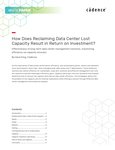Getting rid of old photos and files is never easy — these assets could be valuable in the future and the idea that we may never be able to access them again is anxiety-inducing. For businesses of every size, data is their most strategic and important asset. As the volume of data created increases worldwide – around 23 percent annually – storing and accessing this information cost-effectively long-term is a major challenge.
According to industry analysts, at least 60 percent of all digital data can currently be classified as inactive, and it could reach 80 percent or more by 2025. Even as cloud providers are reinventing their architectures with cost-efficient, accessible archives to keep pace, organizations today must implement the right storage architecture that meets the demands of business while complying with applicable data regulations, whether internal or external.
Enter cool storage. This form of storage is ideal for data that is not actively in use, and while it still needs to be readily accessible, performance is not a priority. As such, there is no need to store this information on more costly forms of storage, which are best reserved for mission critical applications that need that data immediately. For data at scale, the most cost efficient cool storage solutions utilize hard disk drives (HDDs). They have relatively low cost per terabyte, can scale to very large capacities, but are still highly accessible unlike tape. Although tape can cover large capacity requirements, it’s very slow to access that data putting tape firmly in the “cold” storage category.
But how can an organization go about taking advantage of this growing storage need while ensuring a smooth implementation? By keeping execution simple, characterizing data, and drawing a line between backup and cold storage, smart businesses can leverage cool storage to enable efficient, effective storage for valuable data.
Simplifying cool storage
The more an organization is innovating, the more rapidly it is likely generating new data that needs to be retained for longer than ever before. With a cool storage solution, companies can store information that they don’t frequently need access to, yet still need to have readily available for a variety of purposes such as data science and analytics. Cool storage provides the opportunity to store valuable information for long-term use in a more cost-efficient manner, while promising access if and when it’s needed in the future.
Simplicity is key to reap the most value from cool storage solutions, especially for younger organizations that may not have as much information to store as a mature company. In fact, startups are often at an advantage: they have the opportunity to build clean, streamlined storage solutions from the ground up, establishing business-appropriate policies and best practices from the start. What IT leaders must keep in mind is that the temptation to invest in the latest and greatest data storage technology can steer organizations toward complex, multi-tiered infrastructure that could be ultimately more harmful than helpful. This can unnecessarily overcomplicate their architecture and cause confusion for users in the long run.
Characterizing data
Oftentimes, automated IT solutions are relied on to decide where data is ultimately stored, but the common lack of insight required to make informed business decisions that benefit the owners of the data can make it difficult to track down important information. This often leads to faulty accessibility, making for a system that is not user-friendly or effective.
For example, the financial and legal teams at a company might have certain data that needs to be stored long-term for regulatory reasons, but they think it will never be needed for daily business operations. This data is an ideal candidate for cold storage. If an automated system were to determine where this data is stored, it might decide to place it in a storage tier that doesn’t meet the requirements of business users. Making this distinction requires clear communication between IT teams and data owners to characterize data. This mitigates the process of looking for a needle in a haystack when key information is needed most.
There isn’t a one-size-fits-all solution for data lifecycle management. It’s important to consider the data owners’ goals when determining how and where to store information. IT leaders, as the custodians of data, don’t always have the same goals in mind as the creators or owners of the data, so it is important for them to communicate about how and when this information may be needed in the future. By characterizing data and applying different policies to different assets, IT leaders and automated systems can eliminate confusion and ensure that data is stored appropriately and in a way that makes sense for everyone in the short term as well as the long term.
Drawing the line between backup and cold storage
So, what is the difference between backup and cold storage? The Venn diagram may overlap, but these are two different things.
Organizations should treat valuable but inactive data like primary data; it should be online, protected, easily searchable and accessible. A backup, on the other hand, is a copy of your primary data that can be used for operational recoveries if your data is lost or corrupted.
For example, a film company would keep valuable assets – like endless hours of raw footage from the creation of its movies – in cool storage for active access and long-term retention. There, it will be easily accessible as needed but can, for the most part, sit safely in cost-effective cool storage because this footage is not needed for current business operations.
The purpose of backup, however, is to ensure that a company can continue normal operations even if its current dataset is damaged. For example, the same film company might use backup – a copy of current data used for daily activity – to restore its original data in the case of a breach. This will protect the company from any interruption in its day-to-day business operations.
Storage’s future is cool!
The ultimate goal of establishing a cool storage tier is to set up an organization for success while data retention needs and the volume of data generated continues to grow. To accommodate this, it’s critical to keep storage architecture simple, use data owners’ goals to guide characterization, and have a clear understanding of the use cases for backups versus cool or cold storage. Substantial investments toward new innovations in the storage space will continue to grow as every industry is tasked with addressing explosive volumes of data and creating solutions for a cool storage future.





